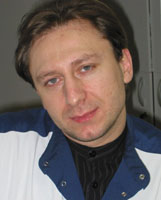|
 Saint Petersburg Institute of Medical Aesthetic Treatments, Russia Saint Petersburg Institute of Medical Aesthetic Treatments, Russia
Education
1988-1994 Saint Petersburg State Medical University Named after I.I.Pavlov(Pavlov University)
1994-1997 Department of Maxillofacial and Plastic Surgery Saint Petersburg State Medical University, specialisation in Plastic and Maxillofacial Surgery.
1997-2001 Department of Aesthetic Plastic Surgery of Saint Petersburg State Cosmetologic Centre, Principal Surgeon and Head of Department.
Since 2001 Saint Petersburg Institute of Beauty,
Principal surgeon and Head of Aesthetic Plastic Surgery Department, Medical Director of Saint Petersburg Institute of Beauty
Past Speaking Experience
1998 Scientific Medical Conference “The latest advances in aesthetic medicine and plastic surgery”, presented lecture “Rejuvenation face and neck surgery “ (Russia, Saint Petersburg)
1999 Scientific Medical Conference “The latest advances in aesthetic medicine and plastic surgery”, presented lecture “Implementation of Endoscopic methods in aesthetic plastic surgery” (Russia, Saint Petersburg)
2001 presents weekly TV program “Laboratory of Beauty” related to aesthetic and plastic surgery.
ABSTRACT
Interest in skin aging is in large part the result of impending demographic
changes related to aging of the baby boom generation. The psychosocial and
physiologic effects of skin aging on older persons have created a demand for
finding new strategies for skin reconstitution and skin rejuvenation. Recent
works have substantially elucidated the mechanisms of skin aging. In
particular, a central role for telomere-based signaling can be inferred.
Intrinsic aging is largely controlled by progressive telomere shortening,
compounded by low grade oxidative damage to telomeres and other cellular
constituents. The loss of telomere repeats with cell divisions may also limit
the replicative life span of skin cells (keratinocytes and fibroblasts).
Our strategy for skin reconstitution and skin rejuvenation is based on the
hypothesis that cloned telomere repeats targeting to the nucleus of cells might
contribute to the mechanism of cell division and longevity of these cells.
Telomere-associated repeats sequences will be amplified in polymerase chain
reaction (PCR) containing total genomic DNA as template and cloned in T-A
vectors. Synthetic peptides containing a nuclear localization signal (NLS) will
be bound to the cloned DNA so that the resulting DNA-NLS complex will be
recognized as a nuclear import substrate. Technically, this approach will be
tested in cell cultures, skin grafts and laboratory animals using liposomes or
peptide vectors. We suggest that our approach may be able to create a new
cellular proliferative history and to prevent and reverse much of the skin
pathology related to the aging.
|
|